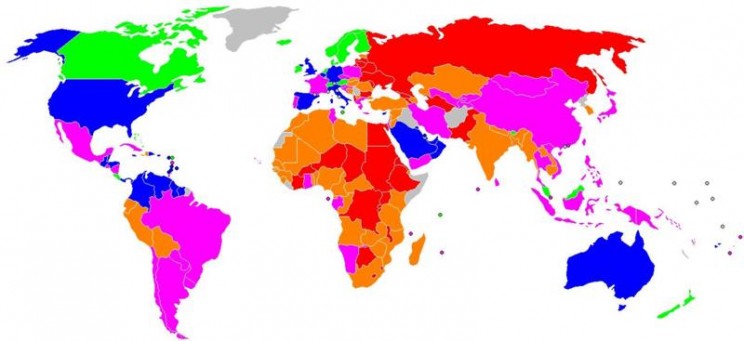For centuries, happiness was exclusively a concern of the humanities; a matter for philosophers, novelists and artists. In the past five decades, however, it has moved into the domain of science and given us a substantial body of research. This wellspring of knowledge now offers us an enticing opportunity: to consider happiness as the leading measure of well-being, supplanting the current favourite, real gross domestic product per capita, or GDP.
The post Why the science of happiness can trump GDP as a guide for policy appeared first on OUPblog.
By Claire Niedzwiedz
How satisfied are you with your life? The answer is undoubtedly shaped by many factors and one key influence is the country in which you live. Governments across the world are increasingly interested in measuring happiness and well-being to understand how societies are changing, as indicators such as GDP (gross domestic product) do not seem to measure what makes life meaningful. Indeed, some countries, such as Bhutan, have measured national happiness for many years. In the World Map of Happiness below, the countries in green (such as Sweden) have the highest satisfaction. The blue countries are less happy than the green, followed by the pink and orange, and finally the red countries (such as Russia) have the lowest satisfaction. The map conjures up all sorts of interesting questions, like what would the map look like if only older or younger people were included or does happiness vary much within a country?

A U-shaped relationship between age and life satisfaction is often reported, meaning that people are happiest in their 20s and their 60s. But what are the factors that help older people achieve high life satisfaction? Research in this area is particularly important as a result of increasing life expectancy and growth in the proportion of older people. Measuring average well-being is only one side of the story, however. Countries which have high levels of overall life satisfaction may have large inequalities between the richest and poorest in society.
What type of country fosters a more equitable distribution of well-being? This is the focus of our paper recently published in Age and Ageing. We studied the influence of socioeconomic position on life satisfaction in over 17,000 people aged 50 to 75 years old from 13 European countries participating in the Survey of Health, Ageing, and Retirement in Europe (SHARE). To measure socioeconomic position, we used a number of different measures that reflected their position in society at different stages of their life. By looking at their relative position in their own country’s social hierarchy, we created a scale that enabled comparison between countries and across the life course measures. From childhood, we looked at the number of books people reported they had when they were aged 10 years old, a measure of the family’s cultural and economic resources. Education level was used as a measure of early adulthood social position and current wealth was taken as a measure of economic position at the time of the survey. We grouped countries into four categories based on the characteristics of their welfare policy and looked at whether socioeconomic inequalities in life satisfaction varied by the type of welfare state a country fits into.
Intriguingly, we found that Scandinavian (Sweden and Denmark) followed by Bismarckian countries (Germany, Belgium, Switzerland, the Netherlands, Austria, and France) had both higher life satisfaction and narrower differences in well-being between those at the top and bottom of society. Scandinavian countries are traditionally characterised by their high levels of welfare provision, universalism, and the promotion of social equality. Bismarckian countries are characterised by welfare states that maintain existing social divisions in society, in which social security is often related to one’s earnings and administered via the employer. Southern (Greece, Italy, and Spain) and Post-communist (Poland and the Czech Republic) countries, which tend to have less generous welfare states, had lower life satisfaction and larger social inequalities in life satisfaction. The number of books in childhood was a significant predictor of quality of life in early old age in all welfare states, apart from the Scandinavian type, and the relationship was particularly strong among women in the Southern countries. On the whole, however, inequalities in life satisfaction were largest by current wealth across the majority of welfare states.
Our findings have important implications, especially given the welfare policy changes taking place across Europe and the growth in wealth inequalities. It raises questions about how future generations of people are going to experience their early old age. Will average well-being and inequalities between the richest and poorest change as less welfare support is available? What will be the impact of increases in the retirement age? It is clear that these are urgent questions which affect us all and that the policies governments pursue are likely to shape the answers.
Claire Niedzwiedz (@claire_niedz) is a final year doctoral researcher at the University of Glasgow’s Institute of Health and Wellbeing and is part of the Centre for Research on the Environment, Society and Health (CRESH). They tweet at @CRESHnews. She is the author of the paper ‘The association between life course socioeconomic position and life satisfaction in different welfare states: European comparative study of individuals in early old age’, published in the journal Age and Ageing.
Age and Ageing is an international journal publishing refereed original articles and commissioned reviews on geriatric medicine and gerontology. Its range includes research on ageing and clinical, epidemiological, and psychological aspects of later life.
Subscribe to the OUPblog via email or RSS.
Subscribe to only science and medicine articles on the OUPblog via email or RSS.
Image credit: Satisfaction with Life Index Map coloured according to The World Map of Happiness, Adrian White, Analytic Social Psychologist, University of Leicester. Public domain via Wikimedia commons
The post Inequalities in life satisfaction in early old age appeared first on OUPblog.




